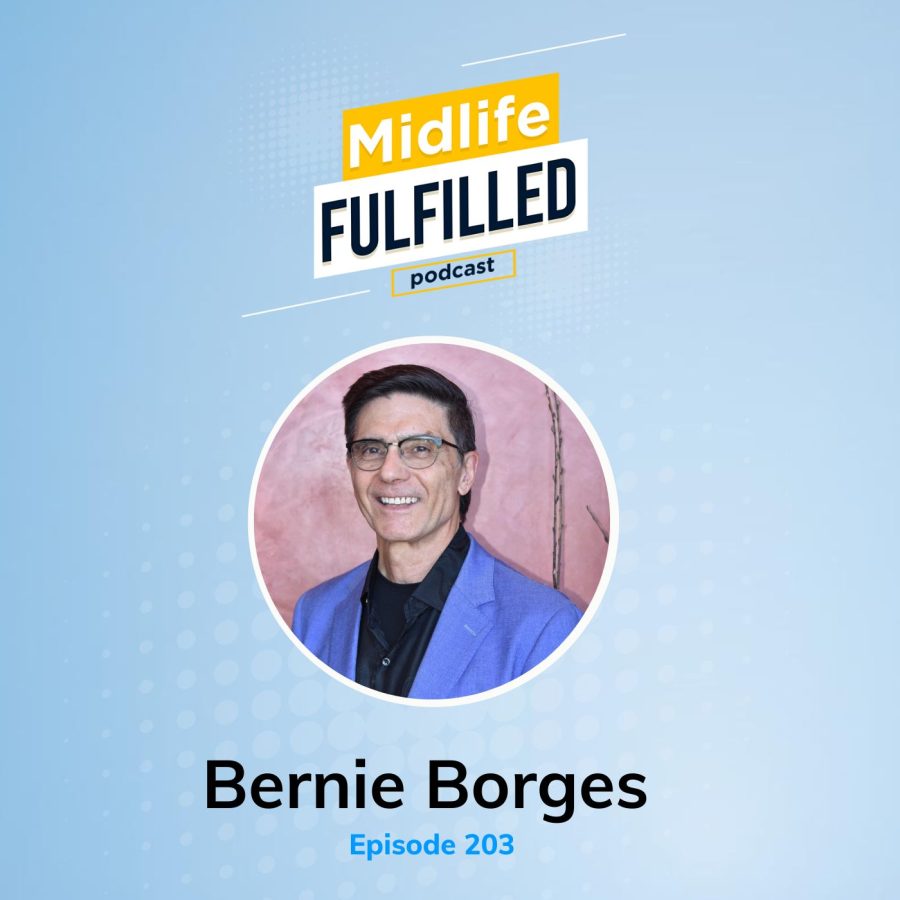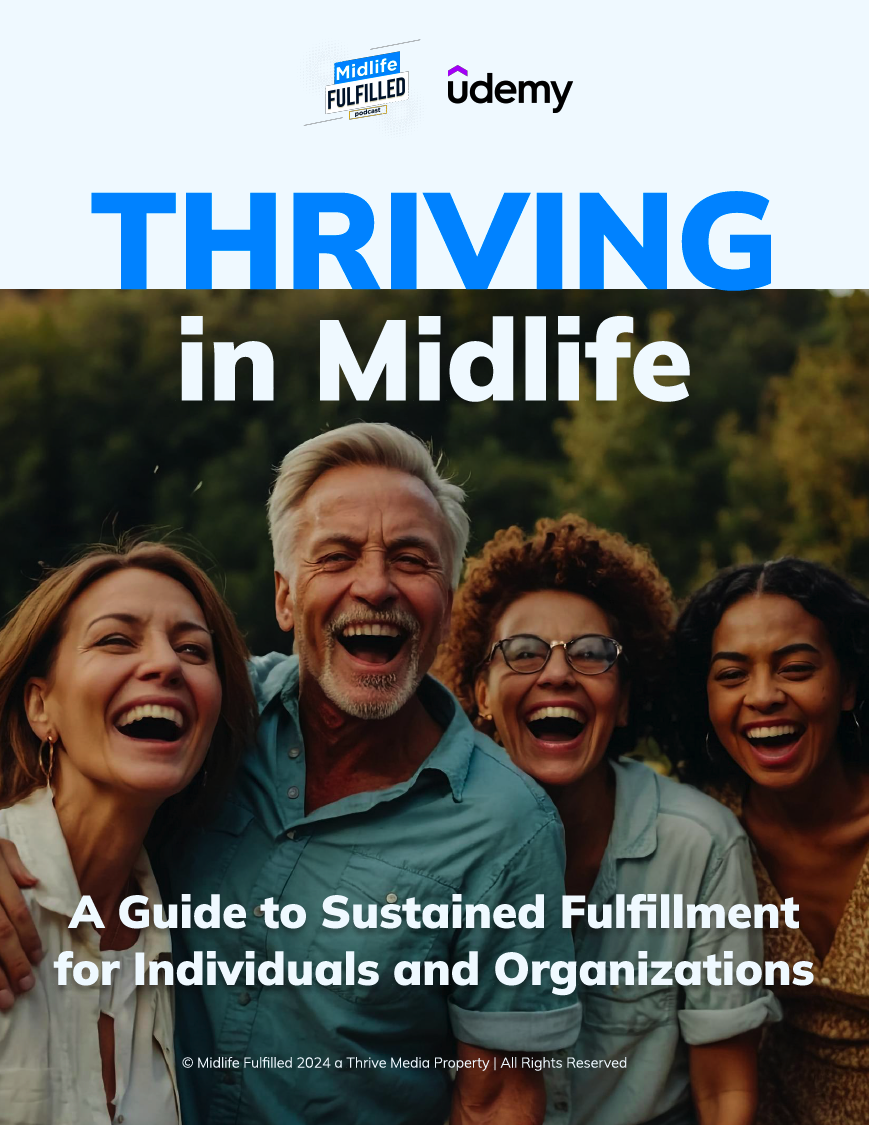Welcome to this On My Mind episode, episode 203. I’m Bernie Borges, your host of the Midlife Fulfilled Podcast. And this is a special On My Mind episode. The reason it’s it’s special is, as I said in the introduction, I am excited to bring to you a summary of my new report research report, thriving in midlife, survey results on fulfillment across key life pillars. Well, if you’ve been following the podcast for a while, you know that this report has been in the making for several months. If you took the survey back in May of 2024, first of all, thank you very much for taking the survey.
Bernie Borges [00:00:52]:
You know, the survey was anonymous, so I don’t know if you took the survey unless you reached out and you told me. So thank you. And a special thank you to the team at Udemy with whom I have partnered to produce this report. And on this episode, I’m gonna bring you some key findings and some highlights of the report. As I mentioned in the introduction, I hope that you’re watching this episode on video. If you’re not, that’s okay. You can still scroll over to the show notes page and access the report. You can just click on the little link there to download the report.
Bernie Borges [00:01:24]:
The report is free for any individual to download and consume. It’s also available for corporate licensing for for teams, if you wanna explore that option. So what I’m gonna do is I’m gonna walk through on screen some key findings of the report, kinda explain how the report is laid out so that you have a good understanding of that because it’s a big report. The report is a 157 pages long. But we structured it in a way that the executive summary gives you a really good understanding of the key findings, and then the table of content, which is very easily accessible, lets you click on any topic that interests you so you can drill down on that. So why don’t we dive right in? So if again, if you’re watching on video, you see the, the opening screen here. Thriving in Midlife, is the the title page. And then the introduction just provides, of course, a brief introduction to the report.
Bernie Borges [00:02:21]:
And then here, you see the table of contents. The table of contents is spread across 2 pages. And if you look at the executive summary beginning on page 5, and then the next section begins on page 17, so we’re talking a 12 page executive summary, and I’m gonna spend a part of my time with you here on video in that executive summary reviewing, the key findings. But I just want you to see how extensive this table of contents is, and you can see that it goes all the way down to page 156 is where the acknowledgments and copyright notice and the overall closing is. So but, again, the table of contents really makes it easy to for you to navigate the report. So let’s begin with the executive summary. We’ll just jump right there. Because in the executive summary, we we give some highlights about the report and specifically around the 5 pillars of midlife fulfillment, health, fitness, career, relationships, and legacy.
Bernie Borges [00:03:22]:
If you’ve listened to the Midlife Fulfill podcast before, you know that that’s really that’s my platform. I I’m constantly referring to those 5 pillars. I will say as an aside that I don’t think those 5 pillars are limited to those of us in midlife. However, I really call attention to them as our focus in midlife, those 5 pillars. And this whole report is based on fulfillment across those 5 pillars. As I scroll through the report, whether the it’s the executive summary or later on when I dive into other pages, you’re gonna see that at the bottom of every page, there is a link that you can click on to go back to the table of contents. So I’m gonna keep scrolling through the executive summary. You see there’s a nice little half page ad here from Udemy, and then we get to the key findings on page 8.
Bernie Borges [00:04:09]:
So let’s walk through some of these key findings. Across each of the 5 pillars, we ask people how fulfilled are they. And for the health pillar, the vast majority, 65.7%, said that they are highly fulfilled in their health. And then 23% said that they’re only moderately fulfilled in their health. Overall, not bad. I think that’s pretty good considering that health is both physical health and mental health. So overall, not bad. The next pillar is fitness pillar.
Bernie Borges [00:04:43]:
How fulfilled are you in your fitness pillar was the question. And 47.3% are highly satisfied, highly fulfilled, and then 23.9, almost 24% are moderately fulfilled. See here, I think there’s definitely some room for improvement. In fact, almost 29% said that they’re low fulfillment. They have low fulfillment in their fitness pillar. So not too surprisingly, however, I’d like to see that improve. There is room for improvement in the fitness pillar among, the people in this demographic. I should point out that we had over 500 of you who took this survey.
Bernie Borges [00:05:19]:
So more than 500 people contributed to these research findings. The next pillar is the career pillar, and I’m happy to report that for high fulfillment, 61.2% expressed high satisfaction with their career, and only 24.2% expressed moderate fulfillment in their career. Now I kind of view that as the glass is a little bit more than half full at 61.2% being highly fulfilled in their career. Honestly, I’d rather see that kinda like a school grade. Right? Think way back to when you got grades in school from, you know, 0 to a 100. Most of us had a passing grade at 70% or higher, so anything less than 70% was not considered a passing grade. I would like to see this hit a threshold of 70% or higher, but it came in at 61.2%. So I think there’s still a little bit of room for improvement there.
Bernie Borges [00:06:17]:
Relationships pillar. Here, we did hit that threshold of 70%. 70% said that they are highly fulfilled in their relationships, and then 17.7% said that they’re moderately fulfilled in their relationships. And then the last question around the last pillar is the legacy pillar. 53% said that they are highly fulfilled in their legacy pillar. And just as a refresher, legacy refers to what’s the impact that you wanna have on fill in the blank, meaning the people you wanna impact, the people you wanna leave a legacy behind, your impact on them, whether it’s family, a cause, whatever it may be. And 53% said that they’re highly fulfilled in that, and 20 almost 27% said that they’re moderately fulfilled in that. So a little room for improvement there as well, but that’s not surprising either.
Bernie Borges [00:07:10]:
So as we go through the report, there’s another finding here around fulfillment versus happiness, which frankly didn’t surprise me, but I think it might surprise many others. And we asked the question, if you could only choose to be happy or fulfilled, which would you choose? Now the survey provides a detailed explanation of what is fulfillment and what is what does it mean to be happy? And so the question was asked asked after that definition was provided. And, are you ready? Drumroll, please. 79.2 percent chose fulfillment, and 20.8% chose happiness. Let’s just round that up. Eightytwenty. If if you wanna know more about the 80twenty principle, go back and listen to episode 3 of the Midlife Fulfill podcast. Yes.
Bernie Borges [00:08:01]:
Episode 3. It’s an entire episode dedicated to the 80 twenty principle. And here we are seeing it in action once again. 80% of the respondents chose fulfillment if they could only choose 1 or the other. Fulfillment versus happiness. That doesn’t surprise me in the least because fulfillment is soul level deep and it’s immutable. It is an achievement. And once we achieve something and we have fulfillment about it, nothing can take that away.
Bernie Borges [00:08:31]:
And that definition was provided in the survey. So that’s some key findings. Let me click back up to the table of contents. You can see how it jumped right back up to the table of contents. We’ve just walked through a good part of the executive summary, not the entire part of the executive summary. In fact, there is actually one section here that I’m gonna point out here, and it’s a little bit of a, shameless self promotion here. There’s an ad on page 13 that shows that this survey that we conducted openly to the public is a survey that we can do for an organization. So if you’re interested in doing a survey similar to this in your organization, get in touch, and we can explore what that looks like in your organization.
Bernie Borges [00:09:16]:
What I wanna do now is I wanna jump around to a couple of highlights. I’m gonna be spending some more time in the coming podcast episodes drilling down into some of these topics. But in this episode, this On My Mind episode, I wanna drill down into just a handful of them. So as I look down through through the the table of contents here, let’s go see the intention to grow professionally. When I click on it, it takes me right to the page. You can see the headline, intention to grow professionally. You can see the bar chart. I’m sorry, the pie chart in the upper right, and you can see that the highest priority for professional growth achieved a 54.3% response.
Bernie Borges [00:10:03]:
So 54.3% of the respondents said that they do intend to grow professionally. And if you keep scrolling, you’ll see that 36.4% said that they were only moderately engaged in growing professionally. So once again, you know, back to that school grade analogy, I think 54 percent is a little on the low side. I would like to have seen this north of 60%, but that’s where it came in. So let’s go back to the table of contents, and let’s look at a few more. Employment status. By employment status, what we wanted to know is where are people currently employed. The largest slice of the pie, literally the pie chart, was 50.6% were employed in a traditional employment for a business or a nonprofit.
Bernie Borges [00:10:56]:
So almost 51%. And then almost 28% were self employed from the people who took this survey, and then another 14% considered themselves or put themselves into the category of entrepreneurship. So that’s not at all surprising. In fact, I like seeing that high of a category or that high of a demographic not demographic, but that high of a representation between independent work self employed and entrepreneurship. I think that is something we’re seeing more of, particularly in the midlife community. I wanna jump down now to, the second page of the table of contents. Again, lots of topics here. And I wanna spend a couple of minutes on the topic of engaging with younger generations in the workplace.
Bernie Borges [00:11:47]:
We had a number of questions on here. In fact, this entire table of contents is comprised of 42 sections. That’s why it’s a 156 page report. So of the 42 sections, we have 5 that are devoted to, actually, 6 that are devoted to the topic of engaging with younger generations. Now if you’ve ever done a survey, then you know something about the following point that I’m gonna make. And that is that, oftentimes, in a survey, we wanna ask a question a few different ways to really gain insight into the topic. If you only ask a question once on a particular topic, you might get a very limited view into what’s really happening around that topic. That’s why we asked 6 questions around engaging with younger generations in the workplace.
Bernie Borges [00:12:41]:
So let’s take a look at this first one here, engaging with younger generations in the workplace. And the predominant collaboration was regular engagement, meaning that those who took the survey, generally over the age of 40, regularly engaged with younger workers in the in the workplace, and the largest swath of of that was 77.5% of the respondents regularly engage with younger generations. And then only 9.1% engaged with younger generations only when it’s necessary. But, again, the biggest representation is 77.5% regularly engage with younger generations in the workplace. Now instead of clicking back to table of contents to go back up, I’m just gonna keep scrolling through this section. And and, again, if you’re not watching on video, you’re on audio, just download the workbook, and you’ll see all this. But, hopefully, my audible description will help you follow along. So the next section is the what’s what was the attitude? What is your attitude about engaging with younger generations in the workplace? And the predominant response, 75.7%, was positive.
Bernie Borges [00:13:58]:
It’s a positive experience. And only 15.1% said it’s neutral, and only 1.5% said that it’s negative. So that’s really good. That’s very encouraging. Again, the biggest representation, 75.7%, said that it’s a positive engagement working with younger generations. The next question on this topic is, what’s the frequency of engaging with younger generations in the workplace? The predominant one was regularly. 63% was regularly. 25.3% was occasional, and only 2.8% was rare.
Bernie Borges [00:14:37]:
So, again, really positive feedback so far on working with younger generations in the workplace. Now here’s where it gets interesting. What is the intent? Your intent was the question. What’s your intent to engage with younger generations in the workplace? The largest representation, 50.2%, is opportunistic engagement. So I’m just gonna read what the report says that the largest segment engages with younger generations when opportunities arise, but does not actively seek them out. Again, that’s the largest representation. Now active engagement came in at 37.4%. Not bad, but the largest representation was 50.2% opportunistic only when it arises but doesn’t actively seek them out.
Bernie Borges [00:15:30]:
So what do we read into this, especially if we’re in a leadership role in an organization? What I read into this, and be curious to to know what you read into this, is that we we need we need to provide those of us in the workplace over 40 more opportunities to engage with younger generations so that we reduce the frequency of it being opportunistic, and we increase the frequency of it being active. That’s my quick read on that. I’d love to know what your quick read on that is or if you’re gonna take more time to actually do a deeper dive on, what that means to you and your organization. Let’s take a look at current, career satisfaction. This one came in really high. 74 a half percent said high. They’re very satisfied with their current career. And 20.8% said that they’re looking to make a change, so let’s round that up to about 21%.
Bernie Borges [00:16:34]:
And then, about 5% said that’s not applicable. So how does that align with the the the environment that you’re in? Now if we go to the second back to the second page of the, the report, I’m gonna jump down to career skills of interest. This is a really interesting one. What are the career skills that people are interested in advancing? Now this is one of a handful of questions in a survey where respondents were invited to select as many answers as they wanted to. And the reason I say that is because the math doesn’t add up, meaning that the numbers, the percentage across them does not total 100. Because if you took the survey, you could have answered you could have selected 3 or 4 choices, not just 1. So the highest tech the highest skill that people want, according to the survey, people wanna develop is technical skills at 49%. 49% of respondents said that they wanna develop their technical skills.
Bernie Borges [00:17:38]:
40% said that they wanna develop their communication skills. And then right behind that, 39.7% wanted to want to develop their creative skills. And then also closely followed is 35.8% wanna develop their personal interaction skills. And then it keeps going. Organizational development skills at almost 35%, planning and project management at 31%, and then other and none of the above. So, clearly, we’re seeing that there’s a lot of interest in our demographic over the age of 40 in technical skills, communication skills, creative skills, personal interaction skills. And that should really should be a really great indicator for anybody in a leadership role as to what, what this demographic is thinking about within their own career development. Okay.
Bernie Borges [00:18:32]:
So I think I’m gonna come close to bringing, this to a wrap because I wanna keep this fairly brief because I really wanna inspire you to download the report and sink your teeth into it so that you can gain insights. I wanna take you to just a couple of thoughts in the closing thought section here. And I’m just gonna share with you, the the last two paragraphs here. Whether refining skills or nurturing relationships or advancing careers, the insights in this report reveal a collective journey toward thriving in midlife. So let this report serve as an inspiring reminder that each day holds the promise of new beginnings and deeper connections and the power to shape a fulfilling future. May this report offer inspiration for both individuals over 40 and to organizations with a workforce that is inclusive of this age demographic to embrace this phase with optimism and a sense of purpose. So, again, what I wanna encourage you to do is to download this report. The the last section here of the report is the acknowledgments and copyright notice.
Bernie Borges [00:19:41]:
And, again, I wanna acknowledge and thank the team at Udemy for partnering with me to develop and produce, this report. I just love what they’re doing. Udemy is a leader in on online, learning for both individuals and for businesses. There’s links in the report where you can learn more about them. I had a a wonderful talented team that really helped shape this report, and they’re linked up in this section as well. And then the bottom of this page here speaks to the the copyright notice of this report. It is a free report for individual consumption, so anybody can download this report and consume it. It is restricted to that individual use.
Bernie Borges [00:20:21]:
So if you’re in an organization and you’re interested in distributing this report within your organization, just get in touch, and we can explore different licensing options that are available. And that is all on the, the last page, call to action for permission requests. So, my friend, I’m gonna leave it there. I hope that this summary of the thriving and midlife report, provides a picture for you, a picture of both where we are currently and where we have some room for improvement, but also where we’re thriving as a midlife community. And I hope that that picture is painted for you individually as well as within the potential of organizations, whether you’re a leader or you’re individual you’re an individual contributor, I hope that that also gives you insight into, that realm as well. Please stay tuned for my little closing message here where I have a final invitation for you. And remember, if you’re 80% fulfilled, my friend, you’re doing great. I’ll see you next time.








